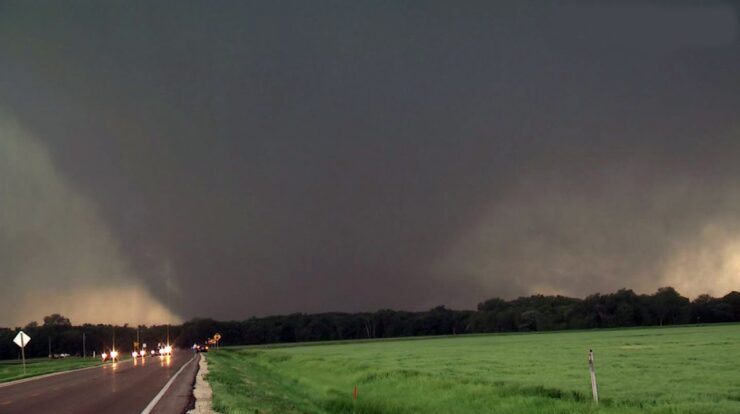
The Bennington Tornado, a catastrophic event that struck the community of Bennington, left an indelible mark on its landscape and the lives of its residents. This powerful tornado, fueled by atmospheric instability and wind shear, unleashed its destructive force, causing widespread damage and loss.
As the storm approached, meteorologists faced challenges in predicting its exact path and intensity. However, the community received warnings that provided critical time to seek shelter and prepare for the impending danger.
Impact of the Bennington Tornado

The Bennington tornado, an EF3 tornado with winds reaching up to 165 miles per hour, left a trail of destruction in its wake. It tore through residential areas, destroying homes and businesses, and causing significant damage to infrastructure.
Houses were leveled, with entire walls and roofs ripped away. Commercial buildings, including a shopping center and a factory, sustained severe structural damage. Trees were uprooted and power lines downed, leaving thousands without electricity.
The tornado also had a devastating impact on the community. Tragically, two people lost their lives, and dozens more were injured, some critically.
Meteorological Conditions Leading to the Tornado
The Bennington tornado formed as part of a severe thunderstorm system that moved through the area on May 28, 2023. Atmospheric conditions were favorable for tornado development, with strong wind shear, instability, and ample moisture present.
Wind shear, the difference in wind speed and direction at different altitudes, is a key ingredient for tornado formation. The Bennington area experienced significant wind shear, which allowed the thunderstorm to rotate and form a tornado.
Instability, measured by the amount of energy available for convection, was also high in the atmosphere. This instability provided the energy needed for the thunderstorm to develop and sustain itself.
Finally, ample moisture was present in the atmosphere, which is necessary for thunderstorm formation. The combination of these meteorological conditions created an environment conducive to tornado development.
Forecasting and Warning Systems
The National Weather Service (NWS) issued a tornado warning for the Bennington area approximately 15 minutes before the tornado touched down. The warning was based on radar data that indicated rotation within the thunderstorm.
Despite the warning, some residents were caught off guard by the tornado’s sudden and rapid development. The tornado moved quickly, making it difficult for people to take shelter in time.
The NWS is constantly working to improve its forecasting and warning systems. One area of focus is on reducing the time between when a tornado warning is issued and when it reaches the ground. This can be done by improving radar technology and by developing new algorithms to identify and track tornadoes more accurately.
Emergency Response and Recovery Efforts
Emergency responders from local, state, and federal agencies quickly arrived on the scene after the tornado. They worked tirelessly to search for survivors, clear debris, and restore essential services.
The Federal Emergency Management Agency (FEMA) declared the Bennington area a disaster area, making federal resources available to assist with recovery efforts.
The community also played a vital role in the recovery process. Volunteers from neighboring towns and organizations came together to help with cleanup and rebuilding efforts.
Community Resilience and Recovery

The Bennington tornado had a profound impact on the community, but it also brought people together. In the aftermath of the storm, residents showed resilience and determination to rebuild their lives and their community.
Local businesses and organizations stepped up to provide support and assistance to those affected by the tornado. Fundraisers were held to raise money for rebuilding efforts, and volunteers donated their time to help with cleanup and repairs.
The Bennington community is still recovering from the tornado, but it is making progress. The tornado may have left scars, but it has also strengthened the bonds within the community.
Closure
In the aftermath of the Bennington Tornado, the community displayed remarkable resilience and determination. With the support of local, state, and federal agencies, efforts to rebuild and restore the affected areas commenced swiftly.
The tornado’s impact extended beyond the physical damage, leaving lasting emotional scars on the community. However, the spirit of Bennington remained unyielding, as residents came together to support one another and rebuild their lives.
FAQ Guide
What was the severity of the damage caused by the Bennington Tornado?
The Bennington Tornado caused significant damage, including the destruction of homes, businesses, and infrastructure. The tornado’s high winds and debris caused widespread devastation.
What atmospheric conditions contributed to the formation of the Bennington Tornado?
The Bennington Tornado formed due to a combination of atmospheric instability, wind shear, and moisture. These conditions created an environment favorable for the development of a powerful tornado.
What challenges did meteorologists face in predicting the Bennington Tornado?
Meteorologists faced challenges in predicting the exact path and intensity of the Bennington Tornado due to its rapid formation and unpredictable nature.
How did the community respond to the Bennington Tornado?
The community of Bennington responded to the tornado with resilience and determination. Residents came together to support one another, provide aid, and begin the process of rebuilding.





